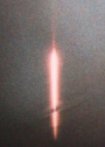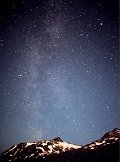|
Summary: Sky watchers around the world were
outdoors August 12th to view the annual Perseid
meteor shower.
Most observers saw no more than 20 to 30 meteors per hour -- a sparse
showing by Perseid standards. Fortunately, the sightings included a
good number of beautiful Perseid
Earthgrazers.
Photographers in Canada also captured unusual pictures of a decaying
Russian rocket that lit up the skies during the meteor shower.
Unless otherwise stated,
all images are copyrighted by the photographers.
|
|
Photographer, Location |
Images |
Comments |
 |
Stan
Richard, Minocqua, Wisconsin |
#1,
#2, #3,
#4, #5,
#6, more |
Stan Richard was Perseid watching on August 12th
at 11:00 pm local time in Wisconsin when a modest display of
auroras broke out. Richard's photos don't include any Perseid
meteors, but they do capture the evening's enchanting Northern
Lights. |
 |
Dautel
Nathalie |
#1 |
This August 12th Perseid meteor (upper middle)
is streaking by the blue star Altair (lower left). Photo details:
50 mm lens f/1.7, 10 minutes exposure on Kodak 800 ASA film
|
Watch & Listen!
 |
Rob
Suggs & Bill
Cooke, MSFC, Huntsville, AL |
3.9 MB Microsoft *.avi movie
file |
The streaking Perseid meteor in this 3.9 MB video
was captured by Bill Cooke and Rob Suggs (Marshall Space Flight
Center Space Environments Group) using a GEN II intensifier and
a 50 mm lens. The sound track plays the meteor's 67 MHz radar
echo. The eerie sounds were recorded by a forward-scatter meteor radar in Huntsville,
AL. |
Just Listen: |
Stan
Nelson, Roswell, NM |
audio files: MP3
or RealPlayer |
Astronomer-engineer Stan Nelson operates a 67
MHz forward-scatter meteor
radar in Roswell, NM -- identical to the one at the Marshall
Space Flight Center in Huntsville, AL. On August 12, 2001, Stan
captured this eerie-sounding echo of a Perseid meteor. |
 |
Jimmy Westlake,
Yampa, Colorado |
#1,
#2 |
In image #1,
a solitary Perseid defies the moonlight. Photo details: 50 mm
lens at f1.8; Kodak Max 400; 25s. Image #2
reveals five Perseids in a nine minute exposure. Photo details:
35 mm wide angle lens at f3.3; Kodak Max 400. J Westlake: "Tracing
their trails backward leads one straight to the radiant near
the Double Cluster at top left." |
 |
Mike
Boschat, Halifax, Nova Scotia, Canada |
#1,
#2, #3,
more |
Rocket Decay: Astronomer Mike Boschat was photographing Perseid
meteors on August 12th when a
dazzling firefall (pictured here) glided slowly across the
Canadian sky. But this was no Perseid. It was the third stage
of a
Russian Molniya-M rocket that had launched a military communications
satellite on July 20th and then returned to Earth on August 12th
-- just in time to catch the attention of Perseid meteor watchers. |
 |
Dominic
Cantin, Quebec, Canada |
#1 |
Rocket Decay: Astrophotographer Dominic Cantin hurridly turned
his camera to photograph a
decaying Russian rocket shell as it streaked over the observatory
of St-Nérée on August 12, 2001. Photo details:
28 mm @ f 2.8 , Kodak supra 400. |
 |
Doug Murray,
Jupiter, Florida |
#1 |
The full-sized
image shows a colorful meteor coming right out of the Perseid
radiant and heading into Cassiopeia. Also visible in the photo
are Taurus, the Moon, Saturn, Aldebaran, Jupiter, Venus and Orion. |
 |
Frankie
Lucena, Cabo Rojo, Puerto Rico |
#1 |
F. Lucena: "I've been trying for over 7
years to capture a Perseid [on film] and finally, under a moonlit
sky and with clouds rolling in, I was able to capture this one!" |
 |
Dominic
Cantin, Quebec, Canada |
#1 |
D. Cantin: "In this picture you can see
a Perseid meteor near center (crossing the trail of an airplane),
the Andromeda Galaxy (bottom left), and the North American Nebula
(upper right)." Photo details: 28 mm @ f 2.8 , Kodak supra
400. |
 |
Mike Klensch,
Skagway, Alaska |
#1 |
Look closely at this
stunning picture of the Milky Way, captured on August 13th,
and you'll see several Perseid meteors streaking among the stars. |
back
to spaceweather.com |









